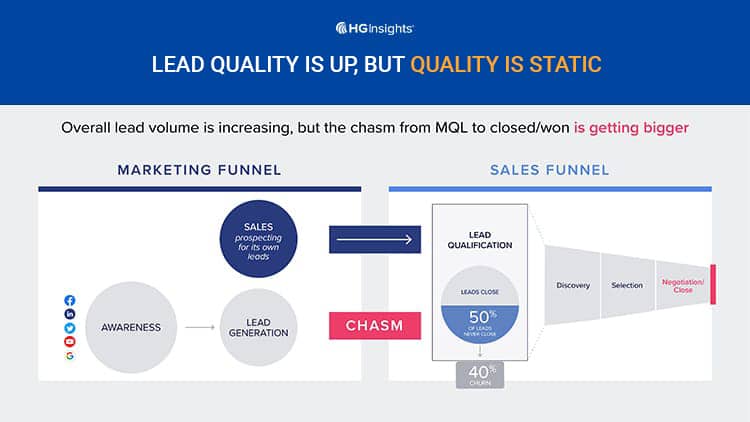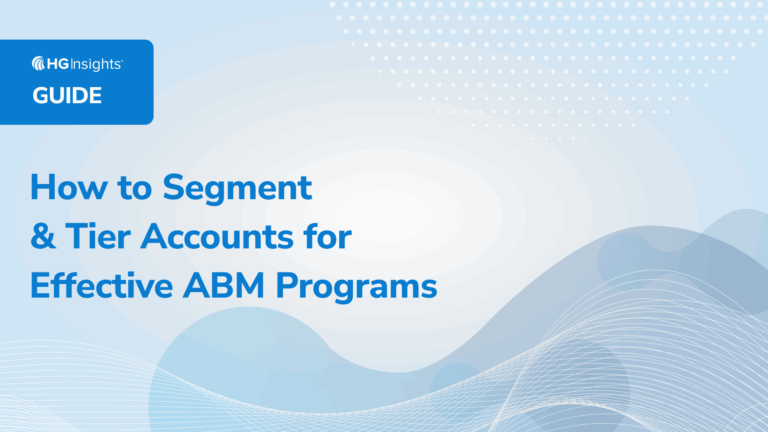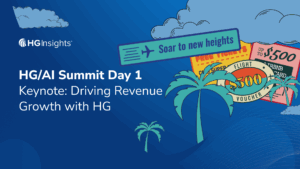So you’ve got your list of target accounts. Now what?
Tiering your list of dream accounts allows you to prioritize your audience based on the campaign you’re running. In our third module, we’ll cover what account segmenting and tiering actually entails, and how to get started.
- What is account segmentation and tiering?
- What role does segmentation play in ABM?
- Which types of data drive account segmentation?
What is account segmentation and tiering?
Edit Content
Account segmentation is the process of differentiating the best fit customers in your Tier 1, 2, and beyond based on the ICPs you’ve developed.
It’s the next step after defining your Ideal Customer Profile (ICP), exploring your Total Addressable Market, and creating a list of target accounts.
When you organize your list of target accounts, it’s essential to segment accounts by key characteristics—potential to convert, highest revenue, engagement, model fit—so that your teams understand which are the highest priority.
As you go through the tiering process, you identify your highest priority accounts (Tier 1), medium priority accounts (Tier 2), and low priority accounts (Tier 3). These accounts are visualized using a pyramid – with fewer Tier 1 accounts at the top and a larger number of Tier 3 accounts at the bottom.
Tier 1 Accounts
Tier 1 accounts represent the best opportunities for your business, and should receive top-notch attention from both sales and marketing – with top sales reps assigned to the account (and the buyers within the account).
Marketing and sales work together to create custom touch points for the company. As the accounts at the top represent large potential deals, vendors invest a significant amount of time and resources into building these relationships.
Tier 2 Accounts
Tier 2 accounts meet many requirements of your ICP – but not necessarily all of your defined characteristics or levels of engagement. These accounts may have a lower lifetime value or lower spend potential with your business than Tier 1 accounts.
They will not receive the same level of customization and priority as Tier 1 accounts, but they still should receive multiple touch points and campaigns targeted at them.
Tier 3 Accounts
Tier 3 accounts display characteristics of your ICP, but not as many as Tier 1 and Tier 2. They are worth paying attention to and pursuing, but not with the same effort as the higher priority accounts.
What role does segmentation play in ABM?
Edit Content
According to the State of Account Based Revenue Engine report, companies that implement ABM achieve 99% higher engagement with target accounts, 80% improved win rates and 73% larger deal sizes. But these strong performances hinge on teams executing ABM properly – and segmentation is a key component of doing it right.
With traditional forms of marketing, teams experienced a problem that looked like:

But consider this: when marketing and sales work together on ABM qualification, fewer leads or prospects accounts fall out of the funnel. As accounts move down the funnel by engaging with the vendor, marketing and sales teams can work on tiering or segmenting potential customers. The process of segmentation helps answer questions like:
- What target accounts will bring in the most revenue?
- Which accounts are most likely to convert?
- What accounts should I contact first?
- What is the potential spend of my different customer segments?
When you look for revenue in the right place, you’ll achieve larger deals, faster sales cycles, and better win rates.
Which types of data drive account segmentation?
Edit Content
There are a number of ways you can approach segmentation depending on factors that impact an account’s likelihood to purchase your product.
When creating a scoring methodology, consider the following factors:
- Model fit: What characteristics does the account have?
- Behavior: What is the account activity across various channels?
- Intent: Is the account showing intent to purchase? (i.e. a demo)
- Needs: What are the account’s pain points? How can your company fit those needs?
Depending on the account’s overall fit with your ideal customer profile (ICP), they are assigned Tier 1, Tier 2, or Tier 3.
As you score your prospects, you can refine the key factors that delineate one tier from another.
When teams begin their ABM program, they’ll need to agree on how many accounts fall within each tier. This will vary dramatically across organizations but will largely depend on the above factors and will change as your company scales.
Ultimately, this is about optimizing your process as you build relationships with your target accounts. At the end of the day, teams will need to research each accounts’ challenges and identify how your product can remedy those problems.
Which types of data drive account segmentation?
When it comes to tiering accounts, it’s most effective to use a variety of data. With different types of data, you can assign a weight to the different factors used to tiered accounts.
Firmographics data
A company’s basic profile can be described using firmographic data—like geographic region, number of clients, employee count, type of organization, industry, and annual revenue.
Firmographic data is a decent starting place for achieving a basic understanding of a company, but to really understand an account, teams need to dig deeper.
Technographic data
Technographic information shows what technology accounts use. This allows marketers to create more effective messaging for campaigns and salespeople to understand how the technology they’re selling fits into an account’s existing tech stack.
Some tools show when an account adds new technology that complements their own and when an account drops competing technology. They don’t, however, give companies context about how technology is used by an account.
Behavioral and intent data
This type of data is generated and stored when an account interacts with your business. It tracks website visits, emails sign-ups, calls and more. Using this data, teams can see how accounts are engaging with content and where they are in the funnel.
If an account is engaging with your business, this should grab your attention because certain events (i.e. reading a case study) mean that the account is getting closer to their decision. Engaged accounts should be top-priority over accounts who may be a better profile fit, but are showing little activity.
Intent data can be first or third-party. This type of data shows the type of content an account is consuming and whether or not an account is interested in purchasing a product or signing up for a purchase.
Contextual Intent data
Contextual data can show companies how accounts are using technology, how much they’re spending on it, when their contracts with other vendors expire, and more.
As you examine companies with a contextual lens, teams can evaluate questions like:
- Will this account go through the funnel quickly?
- Does the account have a compatible tech stack? How are they using it?
- Are accounts partnered with our competitors?
- When are contracts up for renewal or cancellation?
When you look for revenue in the right place, you’ll achieve larger deals, faster sales cycles, and better win rates.




